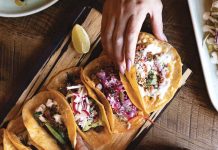Laguna restaurants take their sustainable practices even further with local and organic food, energy conservation, composting and recycling.

By Sharael Kolberg | Photos by Jody Tiongco
Laguna Beach residents have fought hard to protect open space and rallied together to keep the ocean clean. Locals also can help preserve our town’s sustainability by fighting with forks. Demanding food that is local, organic and seasonal is better for our bodies, our town and our planet.
Several Laguna Beach chefs and restaurants are making a concerted effort to serve delicious dishes with the health of their customers and the planet in mind. Some are even going beyond the food by recycling, using reclaimed building supplies and taking other innovative approaches to be environmentally friendly.
For instance, Madison Square & Garden Cafe uses biodegradable products and a tankless water heater, and was the first restaurant in Laguna to install a grease interceptor, which traps oil and prevents it from clogging the sewer lines. Meanwhile, Zinc Cafe & Market opts for biodegradable to-go containers and was among a handful of Laguna restaurants to participate in a pilot program for composting food scraps this past fall. Whether it’s using local produce or keeping food waste out of the landfill, these eco-conscious eateries are taking steps to make their operations even greener.
Garden Grown
Walking the grounds at the Montage Laguna Beach, the resort’s green efforts are evident right away. Strolling up to Studio, the signature on-property restaurant, guests can see the edible garden beds with fresh produce that’s used for sustainable menu items, such as the Tuscan kale salad with purple kohlrabi, duck heart pastrami and focaccia crouton.
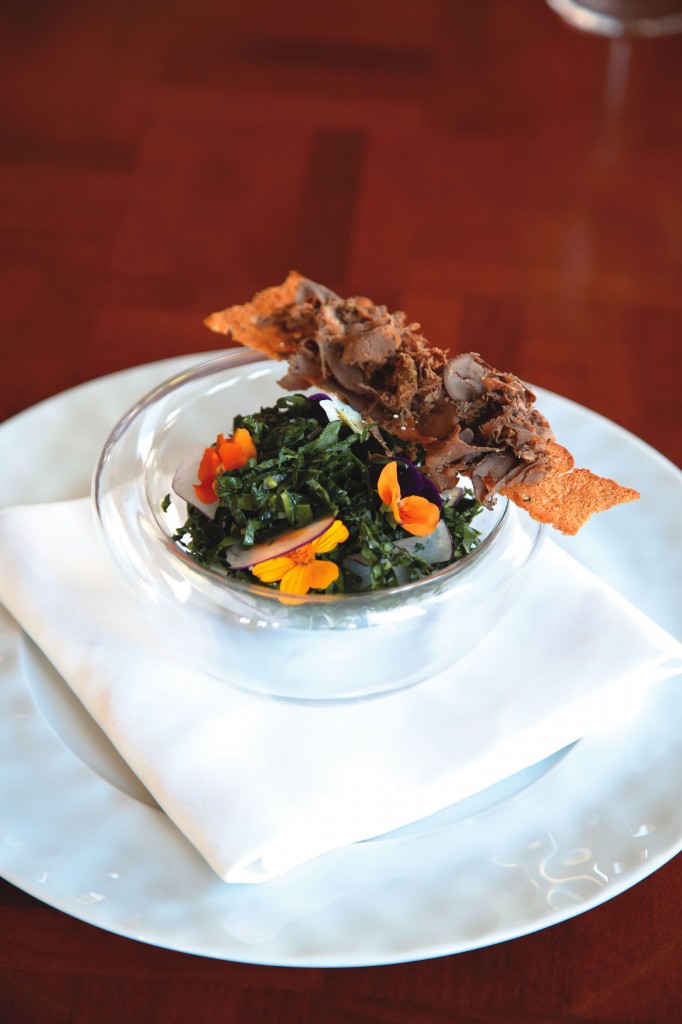
Executive Chef Craig Strong says, “Not only is the garden beautiful and a great use of space, it allows us to grow many delicate items that you just can’t buy because they have a 24-hour shelf life. They would lose their brightness and freshness if they needed to be shipped. People who come to Studio want their food to be delicious and sustainable, but also beautiful.”
The seasonal garden includes items such as pole beans, kale, potatoes, strawberries, lemon trees and a variety of fresh herbs and lettuces. But the garden is just the beginning—Craig strives to be sustainable in most areas of the restaurant. He says a main part of his job is sourcing quality ingredients for the Studio cuisine. “I make many, many phone calls to our suppliers every day about what’s in season, where it’s coming from, how [it] is … being grown,” Craig says.
This practice of knowing vendors is also important for Executive Chef David Fuñe at Splashes restaurant. He adds, “By meeting very special farmers, fishermen and ranchers … I gained a feeling of how much care, detail and love they have for each and every animal, egg, flower, green, carrot, berry. … We preserve all that caring and love that went into providing all this wonderful food to us … and proudly serve it to our guests.”
Living and working on the coast in Laguna Beach, he is passionate about serving fish raised with strict quotas that protect the species for future generations. He tends to favor wild salmon from Alaska, which he says
is the 3Orange County to compost food waste rather than sending it to the landfill. Items that can be composted include fruits and vegetables, baked goods, coffee grounds, tea bags, eggshells and paper products. “It may seem like a little bit, but down the line it’s actually a lot,” Ryan says. “If you’re actually thinking about being sustainable, you’re probably doing things to reduce your carbon footprint. You just have to be conscious.”
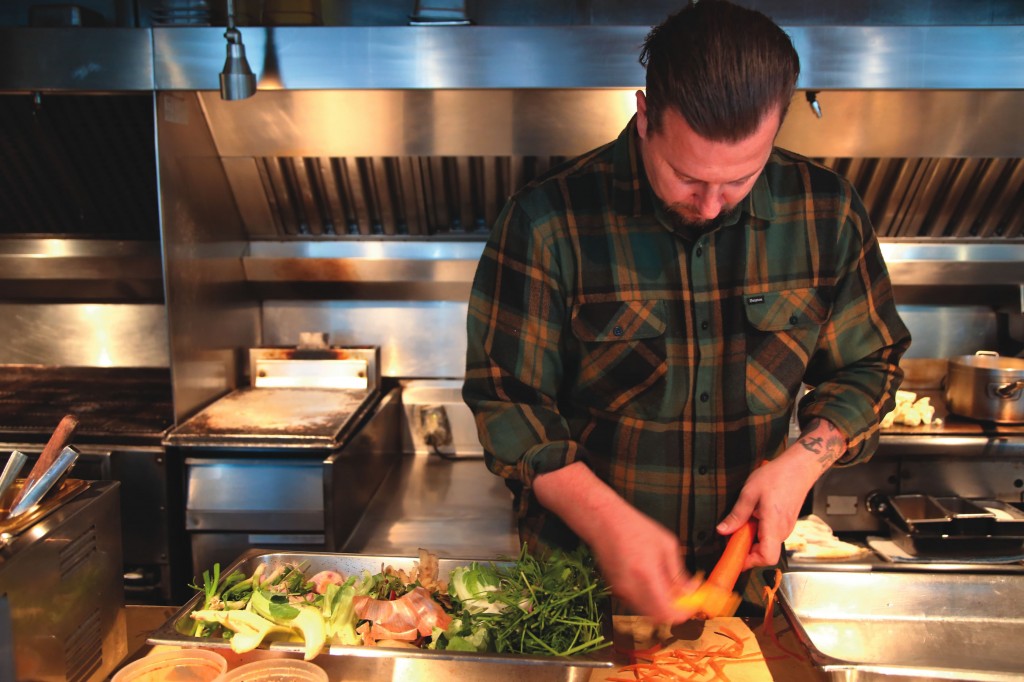
Ryan believes that people need to get more involved in their neighborhoods by participating in projects such as community gardens and food composting programs. In an effort to build community, Three Seventy Common hosts a family-style Sunday Social where guests dine together at one large table. They may select from one of two entrees on a set dinner menu featuring vegetables that are hand-picked by Ryan at local farmers markets.
Protecting Mother Earth
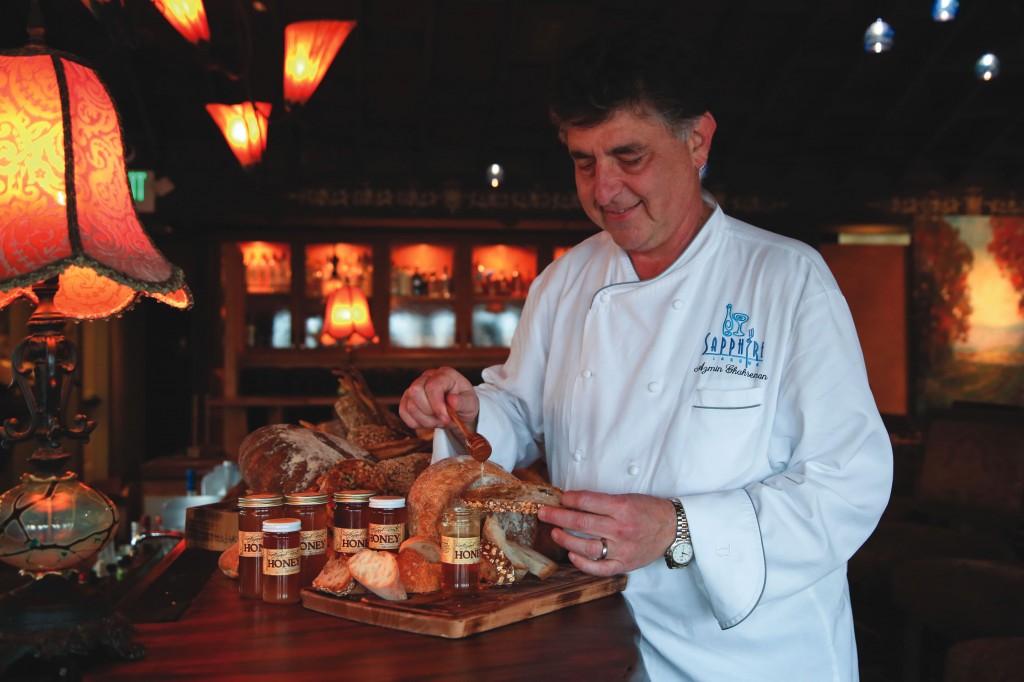
At Sapphire Laguna, conservation is a personal mantra for owner and Executive Chef Azmin Ghahreman. “I am a firm believer that we are born with an expiration date that is stamped. In between, there is a dash,” Azmin says. “You have to make an effort in life and an impact. You can’t leave a light on or waste water. If someone doesn’t know better, we need to educate them.” Azmin practices what he preaches to ensure that his establishment is environmentally friendly.
As for Sapphire’s menu, not only does Azmin serve naturally raised chicken, sustainable fish and natural grass-fed American Kobe-style beef but also fair-trade coffee, organic milk and teas. Additionally, he buys local bread and honey from Bread Artisan Bakery and Backyard Bees, respectively.
He typically uses produce that’s in season, but doesn’t always buy organic because of the high cost that he doesn’t want to pass on to customers. “California is the mother load of produce,” Azmin says. “I try to use as much as possible within my own world.”
Azmin focuses on what’s served on the plate, but he also puts sustainability standards into practice throughout the entire restaurant. To protect our coastal community and prevent harmful runoff into the ocean, the restaurant uses grease traps, does not use chemicals to wash floor mats or walkways, and employs water-saving techniques such as a waterless urinal and top-quality ice machine that uses less water.
To conserve fuel and energy, the air conditioner is adjusted so it’s not overused, the lights are dimmed and the cooks work together to pool resources. As Azmin explains, “Fuel has to come from the war zones that everyone is fighting over.” In addition to limiting energy use, the restaurant also recycles all cardboard, glass, paper, light bulbs and batteries in an effort to protect the environment. Azmin says, “We come from earth and go back to earth, so we need to take care of Mother Nature.”
‘Clean’ Cuisine
Lindsay Smith-Rosales, executive chef and co-owner of Nirvana Grille, describes the menu as “clean” Californian cuisine. Nirvana only serves all-natural meats, free from hormones and antibiotics, organic free-range poultry and sustainable seafood. The restaurant’s practices include buying seasonal produce from farms within California whenever available as well as organic greens, herbs, rice and GMO-free products, as much as possible.
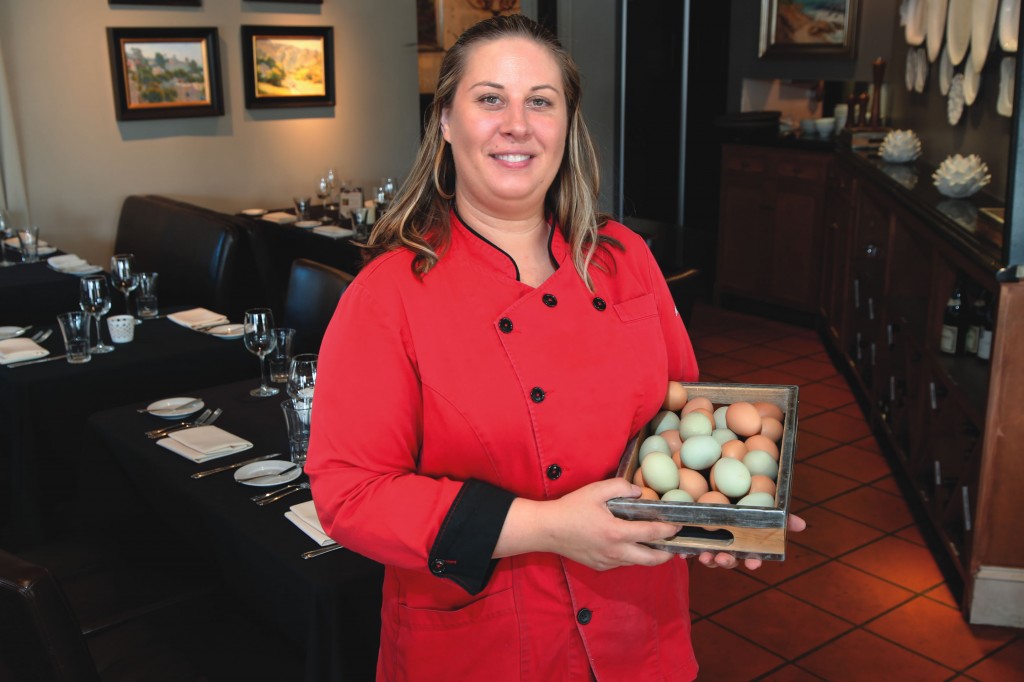
“I believe that we all have a choice to make a difference or ignore it like it is someone else’s issue,” Lindsay says. “We are all responsible for the Earth and what we consume.”
As part of the restaurant’s sustainability efforts, Lindsay uses fresh eggs from the five chickens she raises at her home. She says she hopes to start feeding leftover food scraps to the chickens and using their droppings for compost that will turn into soil for a large garden that’s in the planning stages now. Lindsay says, “If we can find a way to properly manage this, we will be able to utilize a lot of our food waste at the restaurant.”
She admits that restaurants are the biggest generators of food waste while also overconsuming energy and other resources—practices that can be modified to reduce environmental effects. “These are simple changes that can make a positive impact on the community around us and the future for our children,” Lindsay says. “If restaurants could work as a group, locally, instead of trying to undermine or outsell each other, we may have a solution to resources that support common goals of responsible purchasing.”
Keeping it Local
At Maro Wood Grill, Executive Chef Debra Sims attempts to provide a menu that is sustainable, yet delicious. “I try to minimize the carbon footprint without sacrificing the integrity of the food,” Debra says. The restaurant supports local farms and bakeries, and gets its coffee from The Laguna Coffee Co. She says sometimes customers even bring in produce they’ve grown in Laguna Beach, such as lemons, chilies, herbs or artichokes. The menu at Maro can change nearly daily due to the freshness and availability of seasonal produce. Not only does the restaurant support local food purveyors, but it also tends to buy supplies such as business cards, T-shirts and even light fixtures from local businesses.
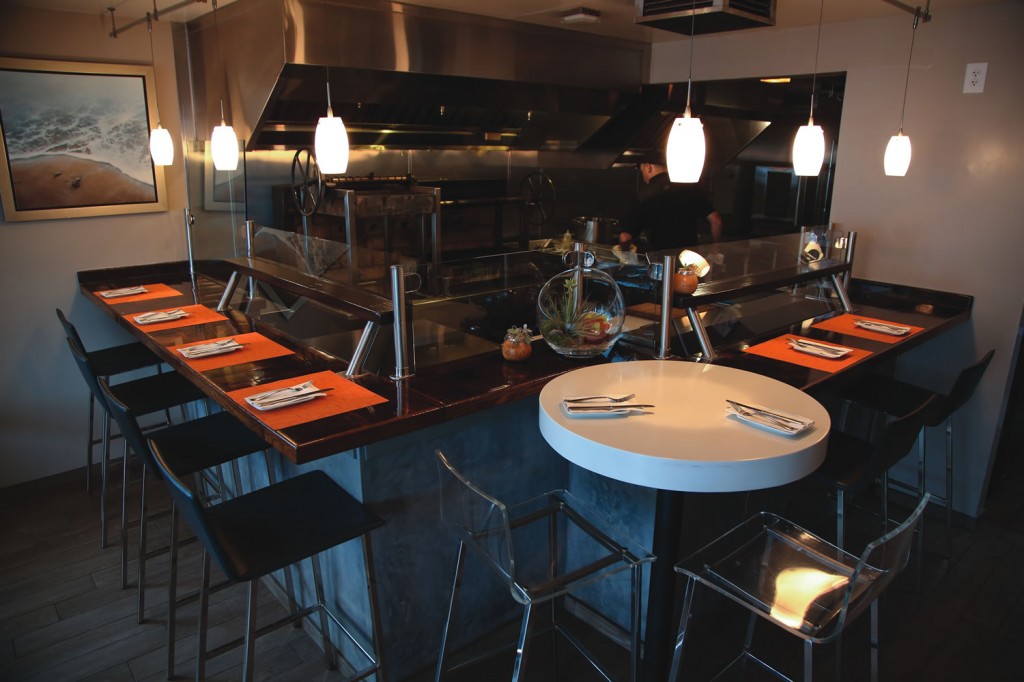
Walking that fine line between ecology and food quality can sometimes mean not buying fish locally. “I am leery of serving fish from [the] Pacific Ocean with the Fukushima radiation leak [in Japan], pollution and urban runoff,” Debra says. She prefers to get fish from a sustainable trout farm in Idaho or from Scotland, where she says clean water practices are in place.
One of the most popular, and sustainable, menu items is the Maro Burger made with 8 ounces of grass-fed ground beef, Nueske’s bacon, aged white cheddar and locally sourced artisan buns, organic iceberg lettuce, Rosso Bruno tomatoes, red onions and house-made aioli and coleslaw. In the future, Debra says, Maro would like to own a herd of cattle to raise locally, just for the restaurant.
As a consumer, Debra says one of the most important things to do is to know where your food comes from, even at the market. “Pay attention as a consumer and ask questions,” she says. “If customers ask, restaurants will do it. Eat at local restaurants, not chain restaurants. Small restaurants can make better choices.”
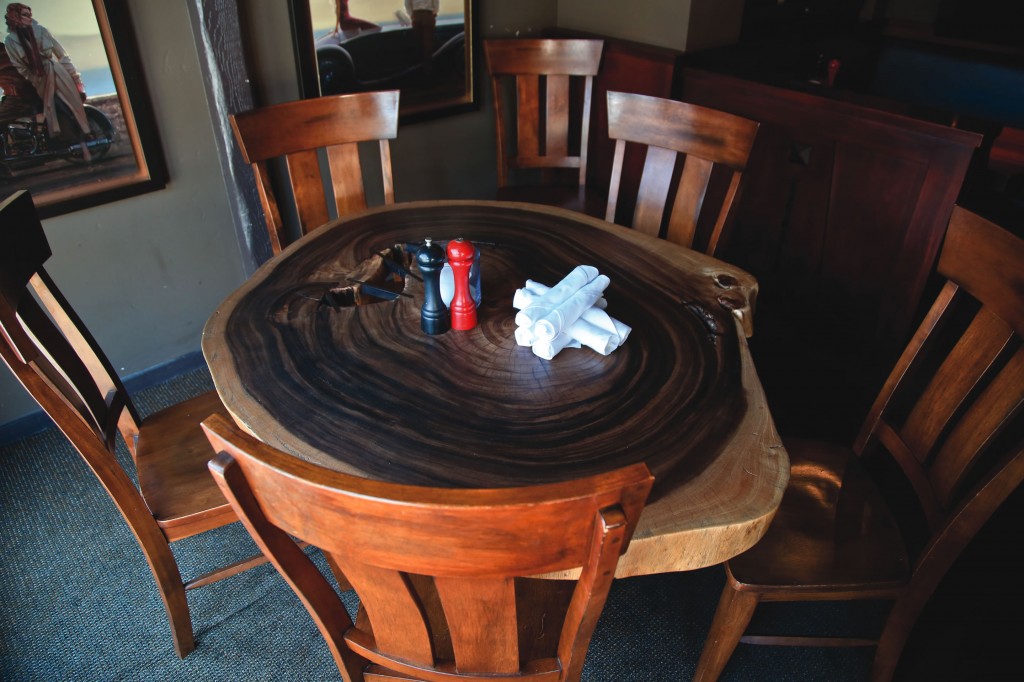
Not only are restaurateurs thinking about the type of food they are serving, but some are also taking it a step further and making green choices when it comes to the building and decor. At Lumberyard, the hostess desk and wine cabinet are made from reclaimed wood, Three Seventy Common’s wood columns are made from Forest Stewardship Council-certified lumber, and Maro Wood Grill uses water-wise succulents for tabletop decor and in planter boxes.
So, the next time you find yourself complaining about how pricey some of Laguna’s restaurants can be, check what’s on the menu. You might be surprised to learn that you’re paying for what you get and, chances are, you’re getting food that is healthy, delectable and good for Mother Earth. LBM




